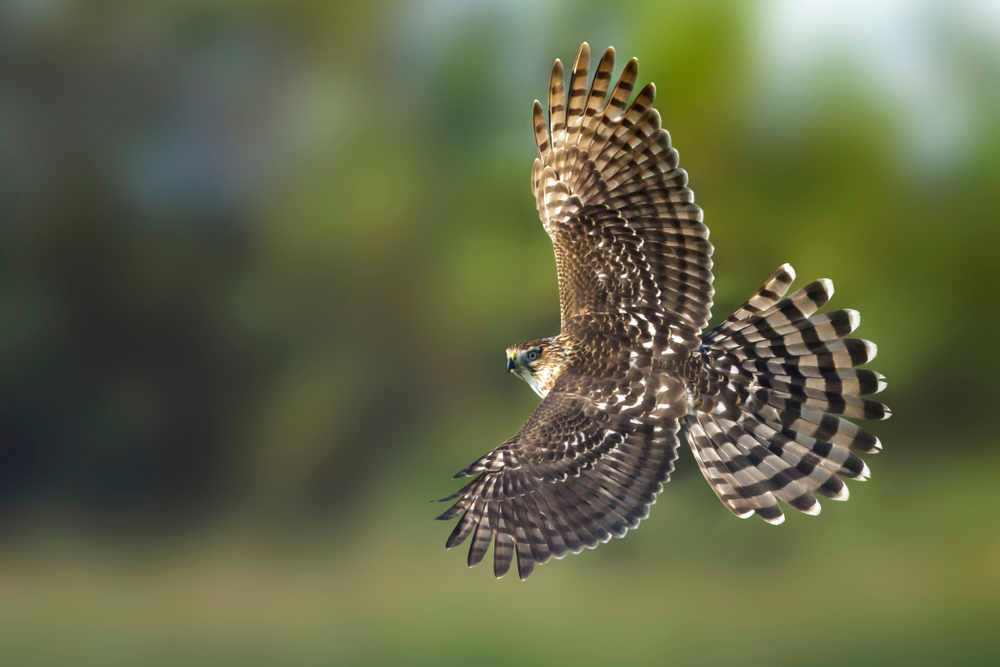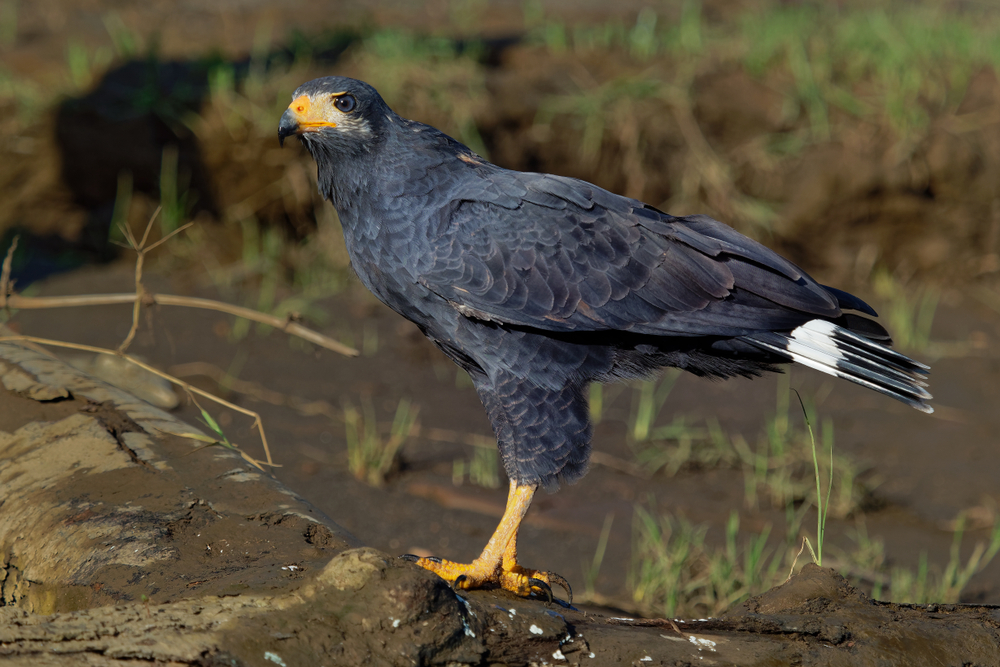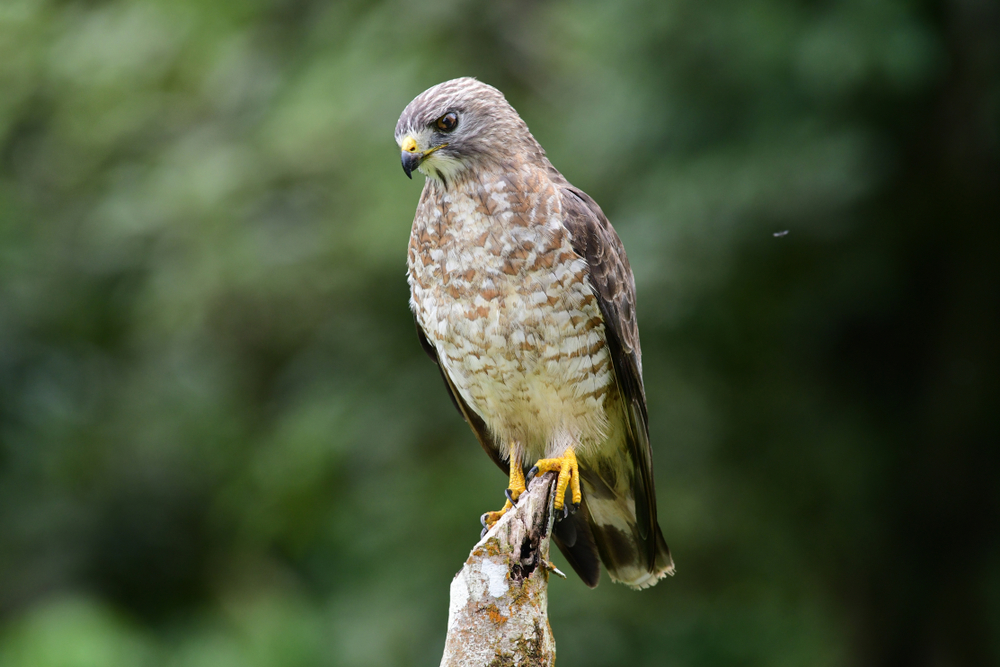The Cooper’s Hawk’s closest relative is the Sharp-shinned Hawk (Accipiter striatus). Both belong to the Accipitergenus, sharing similar builds and hunting styles, though Cooper’s Hawks are larger and more powerful.
About
The Cooper’s Hawk (Accipiter cooperii) is a sleek, medium-sized raptor of the Accipitridae family, widely distributed across North America. Known for its agility and speed, it is a specialist hunter of birds, often pursuing prey with dazzling precision through dense forests, woodlands, and even suburban backyards. This adaptability has allowed the species to thrive in both wild and human-altered environments.
Measuring 35 to 50 centimeters (14 to 20 inches) in length, with a wingspan of 62 to 90 centimeters (24 to 35 inches), Cooper’s Hawks are slightly larger than Sharp-shinned Hawks but smaller than Northern Goshawks. Adults are marked by blue-gray backs, reddish barring on the chest, and a dark-capped head with piercing red eyes. Juveniles are brown above with streaked underparts and yellow eyes. Their long, rounded tail with dark bands and rounded wings are perfectly adapted for maneuvering in tight spaces during high-speed chases.
The diet of the Cooper’s Hawk is dominated by medium-sized birds such as pigeons, doves, starlings, and robins, though they also take small mammals like squirrels and chipmunks. Ambush hunters by nature, they often surprise prey with short, rapid flights from concealed perches.
Breeding occurs in woodlands, often near forest edges. The nest, built high in trees, is made of sticks and lined with softer materials. Females typically lay three to five eggs, and both parents share in feeding the young. Fiercely protective, they will defend nesting sites aggressively.
Once threatened by pesticide use, Cooper’s Hawk populations have rebounded strongly since the banning of DDT and are now listed as Least Concern. Their increasing presence in suburban areas, where bird feeders attract prey species, demonstrates their remarkable adaptability.
With its speed, intelligence, and bold hunting style, the Cooper’s Hawk is one of North America’s most admired raptors.
Physical Characteristics
The Cooper’s Hawk (Accipiter cooperii) is a medium-sized forest hawk of North America, known for its agility and speed in dense woodland habitats.
-
Plumage: Adults have blue-gray backs, reddish barring on the chest, and white underparts with fine rufous streaking. Juveniles are brown above with streaked brown underparts.
-
Face: The head appears square with a blackish cap and contrasting pale nape. The eyes are large—orange to red in adults and yellow in juveniles—giving a fierce expression. The hooked bill is dark at the tip with a yellow cere.
-
Body: Slim and elongated, built for maneuverability in forest hunting. Females are noticeably larger than males.
-
Wings: Short and rounded, with a broad base that allows for rapid flapping and quick turns between trees.
-
Tail: Long and rounded at the tip, marked with several wide dark bands and a whitish tip—one of the most distinctive field marks for identification.
-
Feet: Long and yellow, with sharp, curved talons designed for grasping small birds in mid-flight.
Size:
-
Length: About 14 to 20 in (35 to 50 cm).
-
Wingspan: Between 24 to 39 in (62 to 99 cm).
-
Weight: Ranges from 7.8 to 24 oz (220 to 680 g), with females up to one-third larger than males.
The Cooper’s Hawk’s long tail, short rounded wings, and agile body design make it a specialist in chasing down birds through wooded habitats, often compared to a “jet fighter” of the raptor world.
Reproduction
The reproductive cycle of the Cooper’s Hawk is synchronized with spring and summer in North America, when prey is abundant.
-
Mating and Courtship:
-
Cooper’s Hawks are generally monogamous, forming strong pair bonds that may last multiple years.
-
Courtship displays include aerial chases, circling flights, and the male performing a “sky dance” with exaggerated wingbeats.
-
Vocal exchanges—loud kek-kek-kek calls—help reinforce the pair bond.
-
-
Nesting:
-
Nests are built in tall deciduous or coniferous trees, often 20–60 ft (6–18 m) above the ground.
-
Both sexes contribute to nest building, creating a platform of sticks lined with bark and green twigs.
-
Nests are frequently reused and refurbished in following years.
-
-
Egg Laying and Incubation:
-
The female typically lays 3 to 5 pale blue to bluish-white eggs.
-
Incubation lasts 30 to 36 days, performed mostly by the female while the male provides food.
-
-
Chick Development:
-
Chicks hatch covered in white down and are brooded by the female during their first two weeks.
-
The male supplies prey, which the female tears into pieces to feed the young.
-
As chicks grow, both parents share hunting and feeding duties.
-
-
Fledging and Independence:
-
Young fledge at about 4 to 5 weeks of age, but remain near the nest, still dependent on parents for another 4 to 6 weeks as they develop flight and hunting skills.
-
The Cooper’s Hawk’s cooperative parenting and long dependency period allow fledglings to master the complex hunting skills required to chase agile birds through forests.
Lifespan
The Cooper’s Hawk (Accipiter cooperii) is a woodland raptor whose lifespan reflects both natural predation risks and human-related hazards.
-
Lifespan in the Wild:
Cooper’s Hawks generally live 8 to 12 years in the wild, though some individuals have been recorded living up to 16–20 years. Mortality is high among juveniles, with many not surviving their first year due to predation, disease, or inexperience in hunting. -
Lifespan in Captivity:
In wildlife care facilities, Cooper’s Hawks may live longer, sometimes over 20 years, thanks to steady food supplies and veterinary care, though they are rarely kept outside of rehabilitation centers.
Threats to the Cooper’s Hawk:
-
Predation: Eggs and nestlings are vulnerable to raccoons, crows, and Great Horned Owls. Adults may be preyed upon by larger raptors such as Northern Goshawks.
-
Food Scarcity: Declines in songbird populations or habitat loss can reduce prey availability.
-
Human Hazards: Collisions with windows, vehicles, and fences are a leading cause of mortality, especially in suburban areas where they hunt birds around feeders.
-
Disease and Parasites: Exposure to trichomoniasis (from consuming diseased pigeons or doves) can be fatal.
Despite these challenges, Cooper’s Hawks have adapted well to suburban habitats and are considered a species of Least Concern, with stable and increasing populations across much of their range.
Eating Habits
The Cooper’s Hawk is a skilled avian predator, specializing in hunting birds within wooded habitats and suburban areas.
-
Diet:
Their diet consists primarily of medium-sized birds, such as pigeons, doves, starlings, robins, and jays. They also take small mammals (chipmunks, squirrels, and mice), reptiles, and occasionally large insects. -
Hunting Strategy:
Cooper’s Hawks are ambush hunters, using dense tree cover or urban structures to conceal their approach.
They launch sudden, high-speed chases through trees, using agility and long tails for sharp turns. -
Hunting Behavior:
They rely on element of surprise, often perching quietly before bursting into flight to pursue prey.
In suburban areas, they are frequent visitors to bird feeders, where they prey on flocks of small birds. -
Feeding the Young:
Parents bring prey back to the nest, where the female tears it into smaller pieces to feed chicks during their early weeks. As nestlings grow, whole prey items are provided. -
Unique Habits:
Unlike many raptors that soar in open skies, Cooper’s Hawks are forest specialists, excelling at weaving through trees at high speeds to capture birds mid-flight.
The Cooper’s Hawk’s reputation as a bird-hunting specialist has made it one of the most recognized raptors in suburban environments, where bird feeders unintentionally provide concentrated hunting grounds.
Uniqueness
The Cooper’s Hawk (Accipiter cooperii) is a woodland raptor with several distinctive traits that set it apart from other North American hawks:
-
Forest Specialist: Built with short, rounded wings and a long tail, it is highly maneuverable in dense forests, able to chase prey through tight spaces with precision.
-
Avian Hunter: Unlike many hawks that feed heavily on mammals, Cooper’s Hawks primarily hunt birds, making them one of North America’s most specialized bird predators.
-
Sexual Dimorphism: Females are up to one-third larger than males—a pronounced size difference that helps reduce competition by allowing pairs to target a wider range of prey.
-
Suburban Adaptability: Once rare in urban areas, Cooper’s Hawks have adapted to cities and suburbs, often hunting around backyard bird feeders.
-
Fierce Chase Predator: Known for relentless pursuit, they are capable of high-speed aerial chases, weaving through trees with remarkable agility.
-
Population Recovery: Once heavily persecuted and reduced by pesticide use, Cooper’s Hawks have rebounded strongly, now thriving across much of North America.
The Cooper’s Hawk’s combination of forest agility, bird-hunting specialization, and adaptability to human-altered landscapes makes it one of the most remarkable and successful raptors in North America.
Be the First to Share Photos of This Species.
FAQ’s
1. What is the species closest to the Cooper’s Hawk?
2. How does the Cooper’s Hawk compare to other hawks?
Cooper’s Hawks are medium-sized forest hawks, smaller than Red-tailed Hawks but larger than Sharp-shinned Hawks. Unlike open-country hawks, they specialize in ambush hunting, weaving through dense trees at high speed to capture birds mid-flight. Their adaptability also makes them common in suburban areas.
3. What national parks provide an opportunity to see the Cooper’s Hawk?
Cooper’s Hawks are widespread across North America and can be seen in forested habitats of many national parks, including:
-
Yellowstone National Park (Wyoming/Montana/Idaho) – breeding in wooded areas.
-
Grand Canyon National Park (Arizona) – often seen along forested rims.
-
Great Smoky Mountains National Park (Tennessee/North Carolina) – a stronghold for forest raptors.
-
Everglades National Park (Florida) – wintering and resident populations.
Their broad range makes them one of the most commonly encountered forest hawks in U.S. national parks.





































































